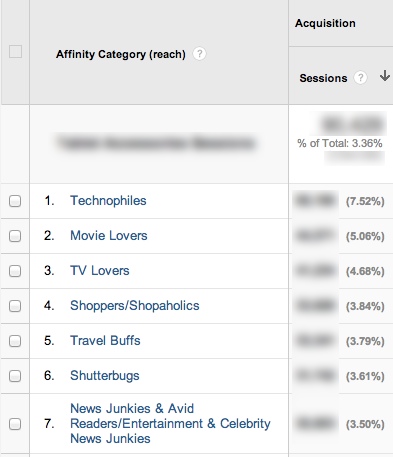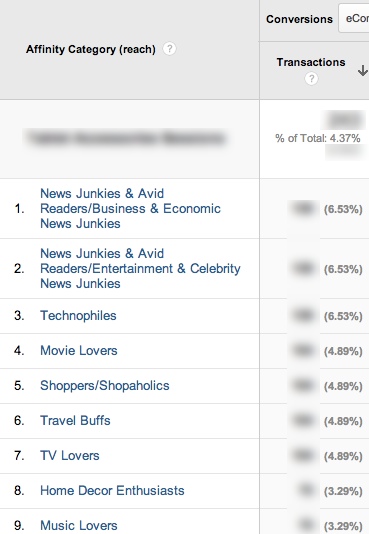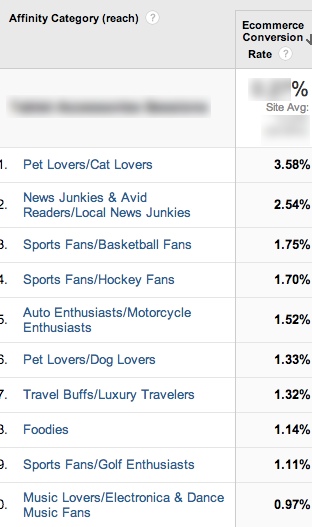
Using Audience Data to Optimize Website Experience
Integrating audience data is a very powerful way information a marketer could have to plan and reach the right segment of the audience a brand has to go after. As audience data becomes available or able to integrate into tools like web analytics software, companies can now optimize the site experience by understanding three key points here:
1. Type of audience the site is attracting.
2. Type of audience is the e-commerce site converting.
3. Type of audiences the site should attract more due to a better opportunity to convert.
Google Analytics allows Ad Words integration with retargeting enablement as an option. In that process, you can determine if you want to pull in audience data to Google Analytics. Make sure to check with your privacy policy so that these type of data enablement aren’t violating your privacy policy.
1. Type of audience the site is attracting.
First thing marketers typically do is plan their marketing effort around reaching the audience they need to go after. So the 1st point here is really looking at the traffic to your site by the audience type. I’ll be using data from ‘Affinity Category’ as the main examples.
I love using the advanced segmentation. If you have a site with different sections that potentially attract or reach different audiences, then it is worth segmenting your data to a particular section so audience data is applied more specifically to a subset of website’s data. My examples here are actually using particular segments of sessions based on users who have visited a certain part of a site. The reason I did that is I wanted to be specific to a particular category of business the site is offering. (For example, if your site offers watches and necklace, you could be segmenting your data to sessions that include any pages that belong to watches.)
Here is an example. This data shows a segment based on sessions that hit a certain section of the site. Notice the kinds of affinity categories this site section if attracting. You’ll notice that this data is really different when we sort with different data from sessions.

2. Type of audience the site is converting. (e-commerce site)
If you sort the data by the transaction, you may see that the site is attracting and converting audiences that are different from above. Hence people who are buying could be different from the audience you’re getting the most traffic from. If you’re paying and targeting for an audience who aren’t buying your service or product, then you might want to rethink your paid media strategy.

3. Type of audiences the site should attract more due to a better opportunity to convert.
Again, if you re-sort the data by conversion rate let’s see what we have. It is very interesting to see that we have another different set of audience type on top of the list. Cat lovers…
This tells you where you need to acquire more traffic and the kind of audience you could be targeting more of to drive higher sales or business outcomes. I guess we’ll have to acquire more cat lovers who are local news junkies.

One can argue that the audience data may not be accurate. However, it is what Google AdWords are likely going to be using to help you target your ad, and if it is this data that is being recorded saying the cat lovers are likely going to convert, why not take advantage of it.
What marketers need to be aware is that chasing after an audience that does not fall in the target audience the brand is chasing after is a debate you need to have internally within your company/team. Performance is one thing, but if you’re in a business where audience type matters to your brand and the overall impact of how your brand is perceived, then it is a very important discussion that the entire marketing team needs to be aligned on. So that one department is not chasing after an audience for the sake of conversion, but the debate about how you can strategically attract and convert the right kind of audience for the brand and measure it. In that case, perhaps your goal is to make the all that list we reviewed to have certain audience dominate the top 3.0, but think about it. First, let’s analyze your data.
Digital marketing is changing really fast. What digital marketing had a hard time to measure and integrating data such as the demographic or psychographic data is becoming something of a common practice. Looking at A/B testing tools and where it is going at integrating 3rd party audience data is something to look out for, but it won’t be surprising when you see more of this with web analytics as well.
Bonus
Other interesting ways to use this data is to segment affinity category data and see where this audience land on the site and behave. You might have thought you were reaching that audience on a certain section of your site, but it may turn out you have more work to do to place the right message for the right audience on places you never put many efforts on. Maybe this something I can write more about next time.
Thank you so much for taking the time to read my content. If you've liked what I've had to say please subscribe!
ZoomMetrix Newsletter
Join the newsletter to receive the latest updates in your inbox.